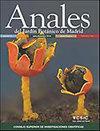羊茅亚属马格里布分支的细胞遗传学关系。采用流式细胞术和FISH技术。
IF 0.7
4区 生物学
Q4 PLANT SCIENCES
引用次数: 8
摘要
羊茅属subgen。雪羊茅是一组阔叶羊茅,可分为两个分支:欧洲羊茅和马格里布羊茅。我们采用荧光原位杂交技术(fish),利用5S和35S核糖体DNA特异性探针和流式细胞术估算基因组大小,以确定马格里布分支多倍体物种可能的亲本基因组。我们的结果表明,八倍体黄花蓟马亚种。atlantigena可能起源于四倍体F. arundinacea亚种的杂交。fenas - 2n = 4x = 28 -和F. mairei - 2n = 4x = 28 -然后是全基因组复制。然而,大量的核型重建和基因组缩小已被揭示。同样地,六倍体的F. arundinacea亚种。科西嘉岛可能是由二倍体的pratensis和四倍体的F. arundinacea亚种间杂交产生的。fenas。本文讨论了十倍体黄花蓟马变种的几种起源假说。本研究增加了我们对阔叶羊茅系统发育的认识,并提供了新的核型信息——染色体数目、倍性水平以及rDNA位点的数目和位置——利用FISH和流式细胞术估计了这一重要草属植物的基因组大小。本文章由计算机程序翻译,如有差异,请以英文原文为准。
Cytogenetic relationships within the Maghrebian clade of Festuca subgen. Schedonorus (Poaceae), using flow cytometry and FISH.
Festuca subgen. Schedonorus is a group of broad-leaved fescues, which can be divided into two clades: European and Maghrebian. We employed fluorescent in situ hybridization —FISH— with probes specific for 5S and 35S ribosomal DNA and genome size estimation using flow cytometry to shed light on the determination of possible parental genomes of polyploid species of the Maghrebian clade. Our results indicate that octoploid F. arundinacea subsp. atlantigena probably originated from crossing of the tetraploids F. arundinacea subsp. fenas —2n = 4x = 28— and F. mairei —2n = 4x = 28— followed by whole genome duplication. However, a large reconstruction of karyotype and genome downsizing has been revealed. Similarly, hexaploid F. arundinacea subsp. corsica presumably resulted from the interspecific hybridization of the diploid F. pratensis and tetraploid F. arundinacea subsp. fenas . Several scenarios on the origin of decaploid F. arundinacea var. letourneuxiana are discussed. This study contributed to our knowledge on the phylogeny of broad-leaved fescues and provided new information on the karyotypes —chromosome numbers, ploidy levels and numbers and positions of rDNA loci— using FISH and genome size estimations using flow cytometry in selected taxa of this important grass genus.
求助全文
通过发布文献求助,成功后即可免费获取论文全文。
去求助
来源期刊

Anales Del Jardin Botanico De Madrid
PLANT SCIENCES-
CiteScore
1.20
自引率
0.00%
发文量
9
审稿时长
>12 weeks
期刊介绍:
Anales del Jardín Botánico de Madrid features original and unpublished articles in fields such as taxonomy and systematics of all plant groups and fungi, including related fields like biogeography, bioinformatics, conservation, ecophysiology, phylogeny, phylogeography, functional morphology, nomenclature and plant-animal relations, as well as reviews and summary works. Anales del Jardín Botánico de Madrid is published half-yearly, with two issues appearing in June and December.
 求助内容:
求助内容: 应助结果提醒方式:
应助结果提醒方式:


